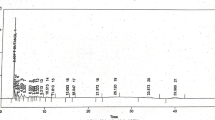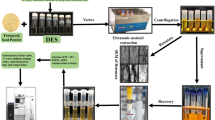Abstract
We proposed here a novel analytical procedure for copper speciation in green and brown propolis extracts using SEC—HPLC—GFAAS with 0.5% m v−1 SDS in 2.5 m mol L−1 Tris–HCl (pH 7.4) as the mobile phase buffer solution. Both basic (0.05 mol L−1 NaOH) and acid (0.05 mol L−1 HCl) conditions were evaluated for sample extraction. Depending on the extraction procedure, differences in copper distribution were identified. Copper was mainly associated with high-molecular-weight (HMW) fractions in green propolis extract when extracted with basic solution, whereas with acid extraction solution, only low-molecular-weight (LMW) fractions were obtained in both samples. Furthermore, combined analysis of results obtained using SEC-UV and GF AAS confirmed the association of copper with LMW and HMW species.





Similar content being viewed by others
References
Cunha IBS, Sawaya ACHF, Caetano FM, Shimizu MT, Marcucci MC, Drezza FT, Povia GS, De O Carvalho P (2004) Factors that influence the yield and composition of Brazilian propolis extracts. J Braz Chem Soc 15:964–970
Isla MI, Paredes-Guzman JF, Nieva-Moreno H, Koo MI, Park YK (2005) Some chemical composition and biological activity of northern Argentine propolis. J Agric Food Chem 53:1166–1172
Sforcin JM, Orsi RO, Bankova V (2005) Effect of propolis, some isolated compounds and its source plant on antibody production. J Ethnopharm 98:301–305
Marcucci MC (1996) Propriedades biológicas e terapêuticas dos constituintes químicos da própolis. Quim Nova 19:529–536
Park YK, Ikegaki M, Da Silva Abreu JA, Freire Alcici NM (1998) Estudo da preparação dos extratos de própolis e suas aplicações. Ciênc Tecnol Aliment 18:313–318
Park YK, Ikegaki M (1998) Preparation of water and ethanolic extracts of propolis and evaluation of the preparation. Biosci Biotechnol Biochem 62:2230–2232
Pereira AS, Silva Seixas FRM, Aquino Neto FR (2002) Própolis: 100 anos de pesquisa e suas perspectivas futuras. Quím Nova 25:321–326
Banskota AH, Tezuka Y, Kadota S (2001) Recent progress in pharmacological research of propolis. Phytother Res 15:561–571
Bankova VS, Castro SL, Marcucci MC (2000) Propolis: recent advances in chemistry and plant origin. Apidologie 31:3–15
Sanz-Medel A (2005) From metalloproteomics to heteroatom-tagged proteomics. Anal Bioanal Chem 381:1–2
Cornelis R, Caruso J, Crews H, Heumann K (2003) Handbook of elemental speciation: techniques and methodology. Wiley, Chichester
Veiga Junior VF, Pinto AC, Maciel MAM (2005) Plantas medicinais: cura segura. Quim Nova 28:519–528
Negri G, Salatino MLF, Salatino A (2003) “Green propolis”: unreported constituents and a movel compound from chloroform extracts. J Apic Res 42:39–41
Araújo CL, Bezerra IWL, Dantas IC, Lima TVS, Oliveira AS, Miranda MRA, Leite EL, Sales MP (2007) Biological activity of proteins from pulps of tropical fruits. Food Chem 85:107–110
Naozuka J, Oliveira PV (2007) Cu, Fe, Mn and Zn distribution in protein fractions of Brazil-nut, cupuassu seed and coconut pulp by solid-liquid extraction and electrothermal atomic absorption spectrometry. J Braz Chem Soc 18:1547–1553
Ponce de León CA, Montes-Bayón M, Caruso JA (2002) Elemental speciation by chromatographic separation with inductively coupled plasma mass spectrometry detection. J Chromatogr A 974:1–21
Welz B, Sperling M (1999) Atomic absorption spectrometry. Weinheim, Germany
Butcher DJ, Sneddon J (1998) A practical guide to graphite furnace atomic absorption spectrometry. Wiley, New York
Naozuka J, Marana SR, Oliveira PV (2010) Water-soluble Cu, Fe, Mn and Zn species in nuts and seeds. J Food Comp Anal 23:78–85
Soldado AB, Blanco González E, Sanz-Medel A (1997) Quantitative studies of aluminium binding species in human uremic serum by fast protein liquid chromatography coupled with electrothermal atomic absorption spectrometry. Analyst 122:573–577
Kannankumarath SS, Wrobel K, Wuilloud RG (2005) Studying the distribution pattern of selenium in nut proteins with information obtained from SEC-UV-ICP-MS and CE-ICP-MS. Talanta 66:153–159
Acknowledgements
The authors are grateful to the Conselho Nacional de Desenvolvimento Científico e Tecnológico (CNPq) and Fundação de Amparo à Pesquisa do Estado do Pará (FAPESPA) for financial support. KGF, PON (Grant CNPq Nº 551983/2009-4) and JAN also thank the CNPq for providing research and fellowship support.
Author information
Authors and Affiliations
Corresponding author
Ethics declarations
Conflict of interest
The authors declare that they have no conflict of interest.
Rights and permissions
About this article
Cite this article
Nunes, P.O., Carvalho, F.I.M., Nóbrega, J.A. et al. Comparative Analysis of the Distribution of Copper in Green and Brown Brazilian Propolis Extracts. Chromatographia 81, 623–629 (2018). https://doi.org/10.1007/s10337-018-3490-8
Received:
Revised:
Accepted:
Published:
Issue Date:
DOI: https://doi.org/10.1007/s10337-018-3490-8




